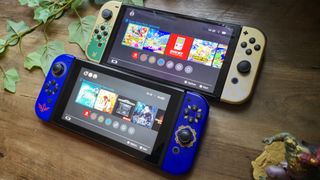The Quest for the Perfect Portable Console: Will the Steam Deck Keep Its Edge?
In the ever-evolving landscape of handheld gaming, Valve’s Steam Deck has solidified its position as a formidable contender. With its recent firmware update in October 2024, enthusiasts of this revolutionary device have witnessed a surge in performance and battery efficiency—an upgrade any portable gamer can appreciate.
Steam Deck’s Latest Update: What You Need to Know
Valve has rolled out a significant update, SteamOS 3.6.19, that promises enhanced performance across various functions and potentially an impressive 10% battery life improvement under certain conditions for the original model. This update not only reflects Valve’s commitment to improving the Steam Deck but is also a response to the rapidly increasing competition in the handheld market, such as the anticipated Switch 2. The decision to base this update on the latest Arch Linux framework alongside Mesa 24.1 for the graphics driver indicates a strategic long-term vision for the console’s framework.
 The Steam Deck: Ready for the Future of Gaming
The Steam Deck: Ready for the Future of Gaming
The firmware update also brings improvements to the reliability of microSD and SD cards, ensuring a smoother gaming experience. These enhancements become essential as gamers flock to the Steam Deck, particularly those who opt for desktop mode—who will appreciate the upgraded KDE Plasma 5.27.10 interface.
The Battle of Displays: Switch vs. Steam Deck
Flipping the script, let’s pivot to Nintendo’s upcoming console, which has fans buzzing with anticipation. Many await the Switch 2, and if the rumors surrounding its screen development are to be believed, an OLED display may not be part of the launch package. A recent statement from industry analyst Hiroshi Hayase, reported by Bloomberg, hinted that an LCD screen would be making an appearance instead. For handheld gamers, this raises some eyebrows; the superiority of OLED technology is hard to overlook.
The arrival of the OLED Switch transformed the handheld gaming experience, offering richer colors and higher contrast—upgrades that changed the way players view their favorite titles. Without an OLED screen, the new model might struggle to capture the same allure that drove sales for the previous iteration.
The Importance of Display Technology
Just as lighting can make or break a photograph, the display quality is central to the handheld gaming experience. Players often remember how it felt to play on older models versus today’s advancements. As someone who revels in games like The Legend of Zelda: Tears of the Kingdom and Mario Kart 8 Deluxe, I can personally attest to the impact that an OLED screen has on the overall aesthetic and emotional engagement of gameplay. Once you’ve experienced those vibrant greens, blues, and detailed textures on an OLED panel, switching back to an LCD feels like stepping into a time machine—one that you’re not eager to board again.
What Lies Ahead for Nintendo?
As Nintendo has historically kept its console costs competitive—launching the original Switch at a significantly lower price than its contemporaries—their strategy often sacrifices initial technological prowess for sustained sales through exceptional first-party titles. A key example is the transition from the original Nintendo 3DS to models with better displays. Just as later variants of the 3DS embraced IPS LCD, the gaming community anxiously awaits the possibility that Nintendo may eventually pivot to OLED technology. Should this happen, it would be a welcome refresh that reflects a broader commitment to gaming experiences rather than just functional hardware.
The market now demands more from portable consoles. Whether a handheld boasts robust battery life or maintains a stunning display will significantly dictate its success among competitors. With ongoing enhancements to devices like the Steam Deck ensuring improved performance and responsiveness, the pressure is on Nintendo to deliver a worthy successor that can hold its own.
 Future projections for the next-gen Nintendo console are heating up.
Future projections for the next-gen Nintendo console are heating up.
Embracing the Future
Ultimately, as we witness an evolving gaming landscape, the need for innovation remains paramount. The Steam Deck and the Nintendo Switch 2 are at the forefront of this evolution, with fans everywhere speculating and hoping for the next best thing. Just as technology always advances, so does the expectation and demand for state-of-the-art features in handheld devices.
Key Takeaways
- The Steam Deck continues to enhance performance via consistent updates, showcasing Valve’s dedication to its users.
- The possible absence of OLED in the Switch 2 could prove disappointing for some, sparking debate over Nintendo’s strategy.
- Ultimately, features like display technology will dramatically influence consumer choices, with the trend increasingly favoring higher-end specifications.
As we gear up for future releases, remember: whether it’s the tactile feel of controls, the beauty of lush in-game worlds, or even the savoring of a quick gaming session on the go—handheld gaming is not just about the games, but how they look and feel in your hands.
Recommended Reads
- Steam Deck 2: everything we know so far
- 10 essential Steam Deck games you’ll keep coming back to
Stay tuned for more insights and coverage on these rapidly evolving gaming fronts!


 Photo by
Photo by 











